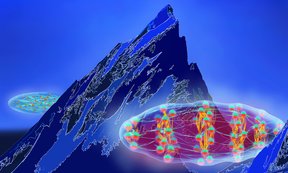Rotons are massive quasi-particles which have large momenta, and, contrarily to the common (quasi)particles for which the energy increases with the momentum, the roton dispersion relation exhibits a minimum at a finite momentum. This unusual behavior expresses the tendency of the fluids to build up short-wavelength density modulation in space. In collaboration with the theory group led by Luis Santos at the University of Hannover and with Rick van Bijnen of the Institute of Quantum Optics and Quantum Information of the Austrian Academy of Sciences, the team led by Francesca Ferlaino at the Department of Experimental Physics of the University of Innsbruck and the Institute of Quantum Optics and Quantum Information of the Austrian Academy of Sciences could quantitative confirm its existence and properties in 2018 in a dipolar quantum gas for the first time. The paper with first author Lauriane Chomaz has been published in Nature Physics and is now ranked in the Web of Science as a Highly Cited Paper. These results have indicated a path to observe the paradoxical “supersolid state of matter”, immediately stimulating the experimental search of such elusive quantum phenomena. Observation of supersolidity has been reported by three independent groups (including Ferlaino’s group) last year.

A cigar-shaped gas of magnetic atoms can support a roton mode: a modulation in the atom spatial organization at a given wavelength, forming a saddle on the energy mountain ridge of its elementary excitations.
Nature Physics: Top publication honored
A publication by the research group led by Francesca Ferlaino on the first-time verification of special quasiparticles in quantum gases was chosen by the editors of Nature Physics as one of their favorite papers of the past 15 years. To mark the anniversary of the journal, which was founded in 2005, the most important works in the various disciplines of physics are presented.
